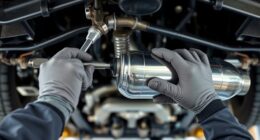You can boost your Ford's performance with free tuning software like Tuner Pro or ROM Raider. These tools are user-friendly for both novice and experienced tuners, allowing you to modify factory settings effectively. You'll need essential hardware like USB adapters and possibly a bench harness for reliable connections. Engaging in online communities can provide valuable insights and support from fellow DIY enthusiasts. Remember, modifications can enhance power and efficiency—but be aware of common challenges like checksum errors. Stay tuned, and you'll discover even more tips to elevate your tuning game!
Key Takeaways
- Free tuning software options are available for older Ford models, enhancing performance and efficiency through DIY modifications.
- Core Tuning software supports J2534 interfaces, allowing for straightforward ECU reprogramming without hardware changes for post-1997 models.
- Community resources, like forums and social media groups, provide valuable insights and troubleshooting tips from experienced DIY tuners.
- Adjustments such as increasing RPM limits and modifying ignition tables can significantly boost engine performance.
- Ensuring accurate ECU modifications with checksum calibration tools prevents performance issues and aids in troubleshooting post-modification.
Overview of Tuning Software
Exploring the world of tuning software can reveal significant performance enhancements for your Ford vehicle. For older Ford models, free tuning software options allow you to modify factory settings without breaking the bank. This DIY approach can lead to noticeable improvements in power and efficiency, making it an attractive choice for enthusiasts like you.
Core tuning software supports J2534 interfaces, enabling straightforward reprogramming of Ford ECUs, especially for post-1997 models that don't require chip modifications. This accessibility means you can engage in the tuning process with confidence, knowing you have reliable tools at your disposal.
Legal protections, exemplified by Bernstein v. DOJ, classify tuning software as protected speech, which promotes user access to these modifications. This means you can explore various community resources on platforms like Reddit and Facebook for insights and recommendations, creating a collaborative environment among fellow DIY tuners.
Given the limited hardware availability since 2022, these free tuning software options become even more essential for enhancing your Ford vehicle's performance.
Embracing tuning software empowers you to reveal your car's full potential, aligning it with your performance goals.
Key Hardware Requirements
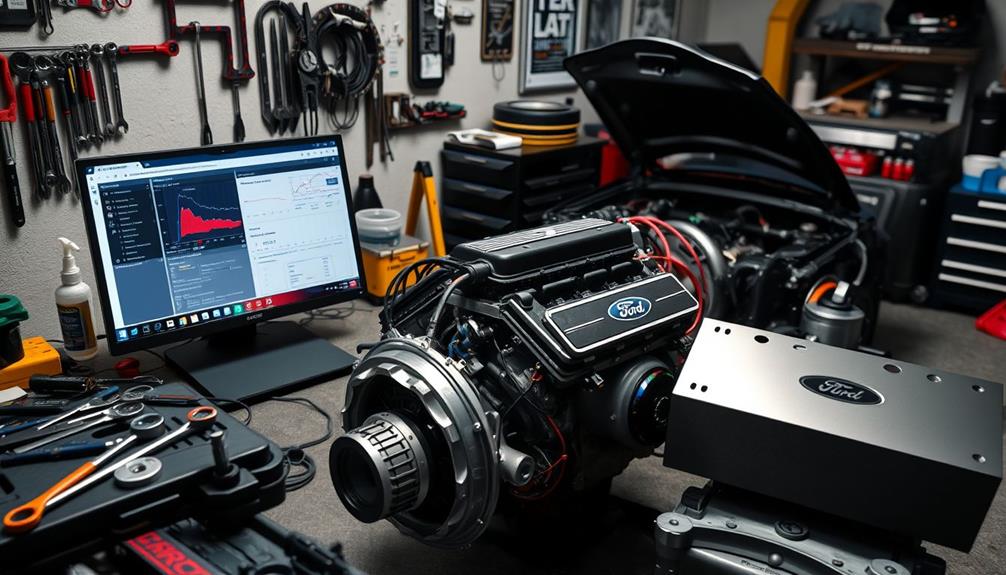
To get started with tuning your Ford, you'll need the right adapters, like USB or Bluetooth, to connect to the software.
A bench harness is also essential to guarantee reliable connections during the tuning process.
Failing to set up your hardware properly can lead to complications with older vehicle computers.
Essential Adapter Types
What types of adapters do you need for effective Ford tuning? When you're diving into DIY performance mods, having the right adapters is essential for communicating with your stock ECU. Here are some important adapter types:
| Adapter Type | Description |
|---|---|
| USB Adapter | Preferred for reliable connection during tuning. |
| Bluetooth Adapter | Offers wireless convenience for tuning software. |
| J2534 Interface | Supports core tuning software, enhancing compatibility. |
| Chip Adapter | Necessary for pre-1996 EEC-IV models for aftermarket tuning. |
For post-1997 models, you can reprogram your ECU without needing chips, making the process smoother. Pre-1996 models require chips for modifications, so keep that in mind when choosing your adapter. Harvesting computers and connectors from older Ford models can also save you some cash while utilizing existing hardware.
Whether you're tuning a classic or a newer model, these adapters will help you achieve peak performance and access your Ford's full potential. So, grab the right tools and get ready to enhance your ride!
Bench Harness Necessity
Creating a reliable bench harness is vital for safely connecting your ECU to power sources and diagnostic tools during the tuning process. Without it, you risk damaging your ECU or facing complications that could slow down your tuning efforts.
The bench harness necessity arises from the need for an efficient setup that allows you to reprogram your ECU without reinstalling it in the vehicle.
You can harvest connectors and parts from older Ford models to build a tailored bench harness. This DIY approach guarantees you have the right components specific to your ECU type.
It's also wise to use USB or Bluetooth adapters for reprogramming, as they enhance compatibility with various tuning software and streamline data transfers.
Additionally, a well-constructed bench harness helps mitigate issues related to aging components, especially in older EEC-IV systems that often require chips for aftermarket tuning.
To aid your project, tap into community resources and forums where you'll find wiring diagrams and harness configurations shared by fellow enthusiasts. This support can guide you in creating an effective bench harness setup, making your DIY performance mods not only possible but also efficient.
Community Resources for Tuning
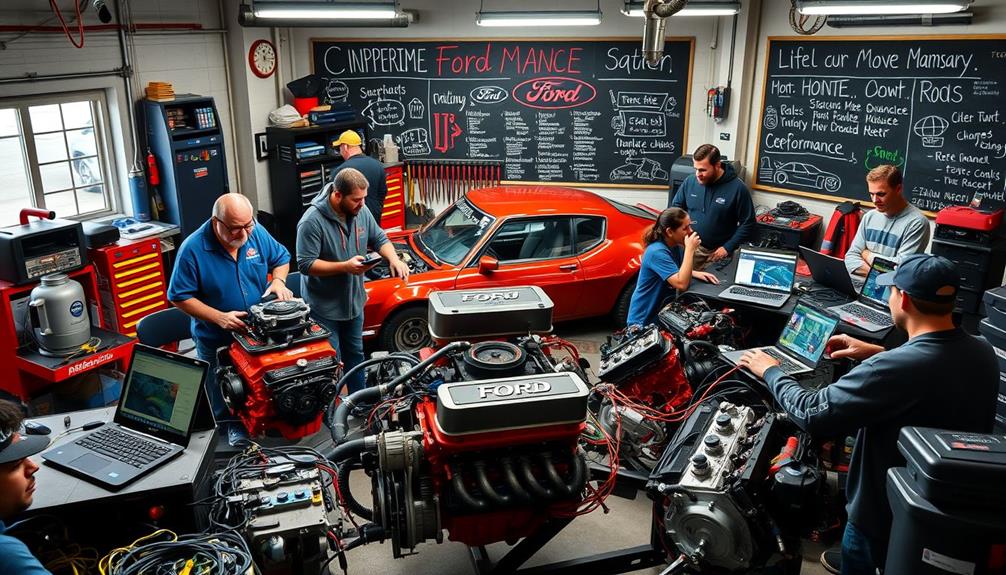
Engaging with online forums and social media groups offers a treasure trove of community resources for Ford tuning enthusiasts. By diving into platforms like Reddit and Facebook, you'll find valuable insights and recommendations for free tuning software tailored for your Ford model. Active participation in these communities means you can share resources, troubleshoot issues, and tap into the knowledge of experienced DIYers.
Here's a glimpse of what you might discover:
| Resource Type | Description | Community Example |
|---|---|---|
| Free Software Lists | Compiled by members | Ford Tuning Forum |
| Troubleshooting Tips | Solutions from experts | Facebook DIY Groups |
| Innovative Techniques | Unique performance mods | Reddit Tuning Threads |
| Hardware Sourcing | Recommendations for parts | Ford Enthusiasts Network |
Collaborating with fellow tuning enthusiasts can lead to innovative solutions, making the journey of Ford tuning more enjoyable. Community-driven knowledge bridges the gaps in resources, ensuring newcomers find their way through the complexities of performance enhancements. Embrace these community resources for tuning, and you'll be well-equipped to tackle your next project with confidence!
Current Market Trends

The landscape of Ford tuning has shifted considerably in recent times, particularly since late 2022 when EPA regulations began to restrict access to essential hardware. This change has made it tougher for you, as a DIY enthusiast, to find the tools you need.
While core tuning software remains a leading option, offering support for J2534 interfaces vital for reprogramming, the overall market has narrowed.
Compared to the GM aftermarket, the Ford aftermarket often emphasizes profit margins over high-volume sales. This focus results in fewer affordable options, making it challenging for you to source the necessary parts without breaking the bank.
You might find that community resources like forums and social media groups are invaluable, helping you stay informed and troubleshoot issues with the tools available.
As DIY tuners face obstacles sourcing aftermarket components like FICM harnesses, innovation and collaboration within the tuning community become essential.
Sharing knowledge and experiences will empower you to navigate these market trends effectively. Finding Ford tuning software free might be more difficult, but engaging with fellow enthusiasts could lead you to hidden gems that enhance your tuning journey.
Common Challenges in Tuning
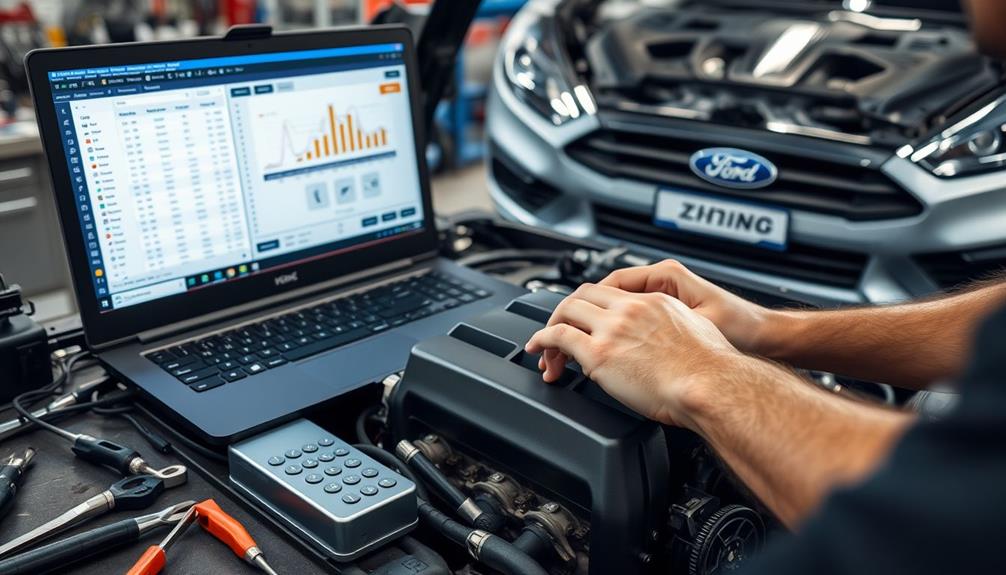
Many DIY tuners encounter a range of common challenges that can complicate the tuning process. For instance, older Ford vehicle computers, particularly EEC-IV systems, often suffer reliability issues, making it tricky to modify pre-1996 models. Additionally, sourcing specific aftermarket parts, like FICM harnesses, can be frustrating and requires patience.
Here's a quick overview of common challenges:
| Challenge | Impact on Tuning | Solutions |
|---|---|---|
| Capacitor/Solder Failures | ECU malfunction | Inspect and replace components |
| Sourcing Parts | Delays tuning projects | Research and network with enthusiasts |
| Boot Mode Activation | Risk of bricking the ECU | Follow detailed guides carefully |
| Trial and Error Tuning | Inconsistent performance | Test in controlled conditions |
| Checksum Errors | Code integrity issues | Use checksum calibration tools |
You'll also find that achieving desired performance often involves trial and error, with factors like fuel quality and temperature affecting results. Finally, keep in mind that checksum errors during ECU modifications can jeopardize your efforts, so always prioritize accuracy in your tuning process.
Tuning Process for Ford Models
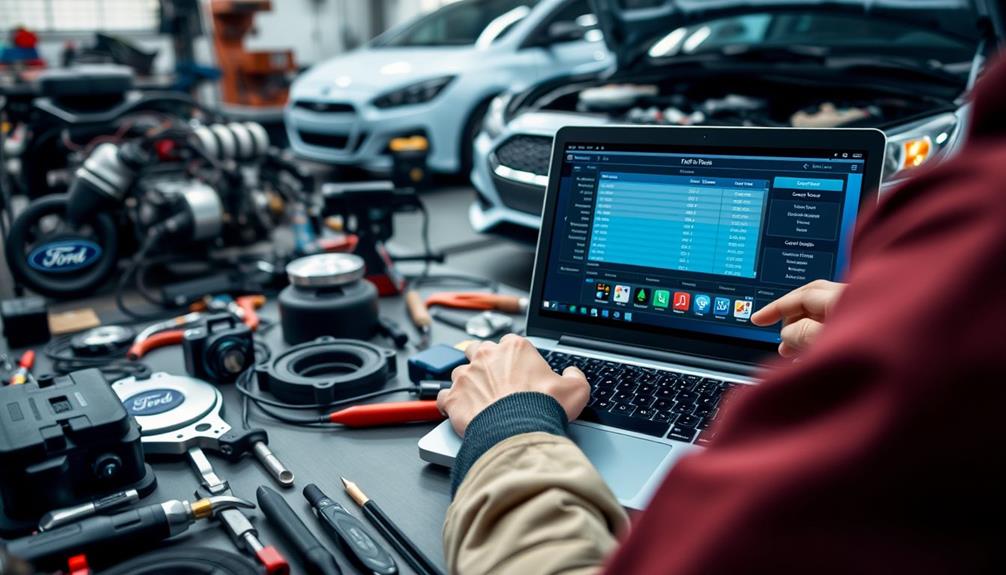
Starting the tuning process for Ford models involves first identifying the ECU model and carefully removing it from the vehicle. This step is essential as it allows you to access the internal data necessary for modifications.
For pre-1996 Ford models, aftermarket tuning typically requires the use of chips, while post-1997 models can be reprogrammed without any physical chip changes.
Once you've got the ECU out, you'll need to download the raw hex data. This data can then be modified using structured XML files, allowing you to adjust specific parameters like ignition timing and RPM limits.
Utilizing free software options, such as Core Tuning, makes this process more accessible, but verify it's compatible with the J2534 interface.
Software Options for Data Modification

When you're looking to modify your Ford's data, you'll find plenty of free software options available.
These programs are compatible with various Ford models, especially older ones, and can help you adjust performance without breaking the bank.
Plus, community resources make it easy to share necessary files, ensuring you have the right tools for successful tuning.
Free Software Availability
Free software options for tuning older Ford models are becoming increasingly accessible, allowing DIY enthusiasts to modify their vehicle's performance without breaking the bank.
With the right tools, you can reveal your car's potential and enjoy a more personalized driving experience.
- Many platforms support J2534 interfaces for seamless ECU modifications.
- Community forums like Reddit and Facebook provide valuable resources and recommendations.
- Core Tuning software is user-friendly, catering to both novice and experienced tuners.
Thanks to the legal backing from the Bernstein v. DOJ ruling, you can confidently access and modify your vehicle's ECU using these free software tools.
This free software availability means you can experiment with performance mods without any hefty fees.
To enhance your tuning experience, XML/XDF files can help structure raw ECU data, making it easier to implement changes that improve performance.
Compatibility With Ford Models
Understanding compatibility with various Ford models is vital for successful tuning. If you're working with older models (pre-1996), be ready to modify physical chips, especially if your vehicle uses an EEC-IV system.
For post-1997 models, however, tuning becomes much easier, as you can reprogram the software without needing hardware changes. This is particularly beneficial for those looking to enhance the performance of their Power Stroke engines.
Free tuning software options, like Core Tuning, support J2534 interfaces, making reprogramming straightforward. You'll find that specific software files, such as XML/XDF, are important for effective data modification, especially for less common Ford ECUs.
As the aftermarket tuning market evolves, keep in mind that compatibility can fluctuate. Regulatory changes may impact your access to certain tools and software, so it's important to stay updated on the latest developments.
Community Resource Sharing
Tuning enthusiasts often find valuable software options through community resource sharing, making the process of data modification more accessible. By tapping into community resources on platforms like Reddit and Facebook, you can discover a wealth of software recommendations and insights that enhance your tuning experience.
Here are some popular tools you might consider:
- Core Tuning: Free software for DIY tuning of older Ford models, perfect for modifying factory settings.
- ROM Raider: Offers a structured interface for editing ECU data using XML/XDF files, making modifications straightforward.
- Tuner Pro: Another favorite among tuners, known for its user-friendly features and efficient data editing capabilities.
Utilizing USB or Bluetooth adapters is essential for reprogramming your vehicle's software, ensuring the tuning process is efficient and user-friendly.
Additionally, active participation in tuning forums can bridge any gaps in knowledge. Engaging with fellow enthusiasts not only provides valuable resources but also support for software options and data modification techniques.
Performance Adjustment Techniques

When it comes to enhancing your vehicle's performance, several key adjustment techniques can make a considerable difference. One effective method is adjusting the engine RPM limiter. By increasing it from 6600 RPM to 7000 RPM, you can access additional power and performance.
Another technique involves modifying the base ignition tables; adding timing degrees can boost your power output, but be careful—improper calibration might lead to unwanted horsepower loss.
You can also tweak speed limiters to fit your driving style. Whether you want to reduce a limit from 210 km/h to 99 km/h or increase it to 250 km/h, this adjustment can optimize your performance based on personal preferences.
Keep in mind that fuel quality and ambient temperature play essential roles in engine responsiveness. Monitoring these factors during your tuning adjustments guarantees you get the best results.
Lastly, employing tools like checksum calibration is important for maintaining the integrity of the ECU code. This safeguards against potential issues like starting difficulties or theft detection after modifications.
Troubleshooting ECU Issues
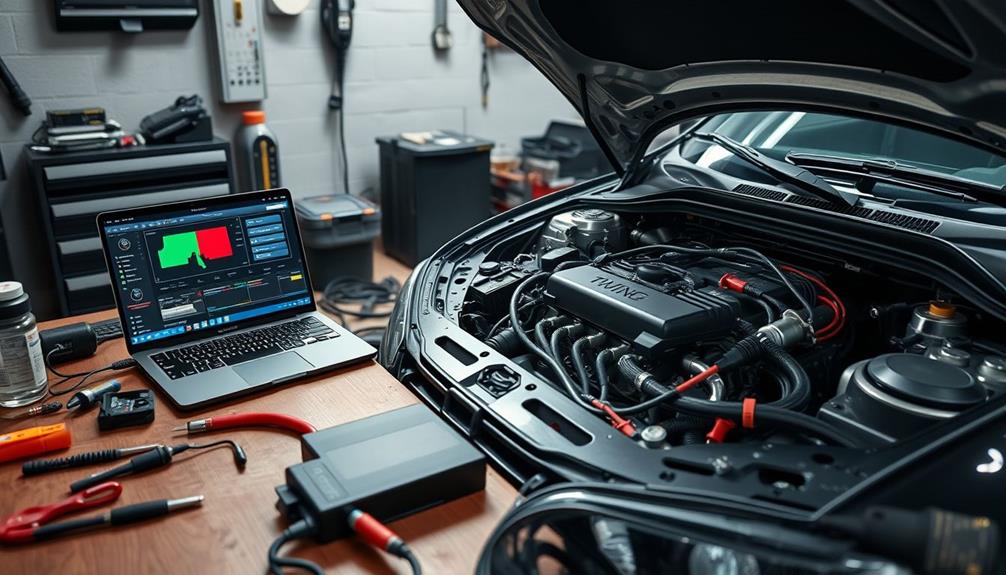
When troubleshooting ECU issues, you'll want to keep an eye out for common error codes that could signal problems.
Syncing the original maps is crucial to prevent triggering theft detection systems, while using checksum calibration techniques guarantees your modifications maintain code integrity.
With experience, you'll find that addressing these challenges becomes quicker and more efficient.
Common ECU Error Codes
Many vehicle owners encounter ECU error codes at some point, making it essential to understand their implications. These codes can provide vital insights into your engine's performance and efficiency.
Here are some common ECU error codes you should be aware of:
- P0101: Mass Air Flow Sensor Range/Performance Problem, impacting air intake and performance.
- P0131: Oxygen Sensor Circuit Low Voltage, often leading to poor fuel efficiency and higher emissions.
- P0420: Catalytic Converter Efficiency Below Threshold, signaling potential failure or blockage.
When you receive these common ECU error codes, it's important to address them promptly. Ignoring these issues can lead to more severe engine problems down the line.
For instance, code P0606 indicates a PCM processor issue, which may require reprogramming or even replacement of the ECU.
Regularly checking and diagnosing these error codes using an OBD-II scanner can help you pinpoint and troubleshoot ECU issues before they escalate into costly repairs.
Syncing Original Maps
Syncing the original ECU map is essential for guaranteeing your vehicle starts properly and operates smoothly after any modifications. When you modify your vehicle, it's vital to have the original map readily available for effective syncing. Failing to sync original maps can lead to starting issues and hinder performance adjustments, making it harder to enjoy the benefits of your mods.
You might encounter memory module checksum errors during the tuning process, which highlight the importance of verifying code integrity. Be certain to use a checksum calibration tool to rectify any discrepancies.
Restoring the ECU can involve a thorough trial and error process, with extensive diagnostics potentially taking several hours to achieve peak performance conditions.
Backing up the original ECU map before making any modifications is a smart move. This practice not only facilitates easier recovery but also serves as a reliable reference point for syncing and code integrity checks.
Checksum Calibration Techniques
Checksum calibration techniques play a significant role in troubleshooting ECU issues, ensuring your vehicle runs smoothly after modifications. Without proper checksum calibration, you may encounter starting problems or malfunctioning systems that can derail your performance goals.
Here are some key considerations:
- Verify modified code accuracy with checksum calibration tools.
- Perform thorough diagnostics to address memory module checksum errors.
- Share experiences in tuning communities to learn faster troubleshooting methods.
Utilizing a checksum calibration tool is imperative for confirming that your ECU modifications are accurate, helping to prevent errors during the upload process.
If you face checksum-related errors after tuning, it's important to conduct a detailed diagnostic check to restore your ECU's functionality. Often, achieving the correct checksum involves extensive trial and error, with multiple attempts over several hours to rectify performance issues.
Engaging With the Tuning Community

Engaging with the tuning community can greatly enhance your DIY Ford tuning experience. By participating in online forums and social media groups, you gain access to a wealth of insights and resources tailored for Ford enthusiasts. Platforms like Reddit and Facebook are ideal for exchanging tuning experiences, troubleshooting tips, and recommendations for compatible software and hardware.
When you collaborate with other DIY tuners, you can discover innovative solutions to common challenges, such as sourcing the right hardware or maneuvering complex software issues. Many tuning communities focus on sharing knowledge, creating an environment where beginners can learn from the expertise of seasoned tuners.
Active involvement in these discussions not only boosts your understanding of tuning techniques but also keeps you updated on market trends and the latest tools available for Ford tuning.
You'll find that engaging with the tuning community fosters a spirit of collaboration and support, making your tuning journey much more enjoyable and rewarding. So, don't hesitate to plunge in and connect with fellow enthusiasts; the insights you gain can greatly elevate your DIY tuning projects.
Frequently Asked Questions
Is There Free Car Tuning Software?
Yes, there's free car tuning software available. You can use tools that support J2534 interfaces, access community forums for tips, and modify settings to enhance your vehicle's performance without spending any money.
Can I Tune My ECU Myself?
Yes, you can tune your ECU yourself, but you'll need the right tools and knowledge. Be prepared to handle raw data carefully, and check community forums for tips to avoid potential issues during the process.
What Is the Best Car Tuning Software?
Did you know that over 70% of car enthusiasts prefer DIY tuning? When choosing the best car tuning software, consider options like ROM Raider or Tuner Pro for their user-friendly interfaces and strong community support.
What Software Is Used to Remap an Ecu?
To remap an ECU, you'll typically use software like ROM Raider or Tuner Pro. These programs help you modify factory settings, enhancing performance by adjusting parameters like ignition timing and RPM limits effectively.
Conclusion
To sum up, exploring free Ford tuning software can lead to impressive performance improvements for your vehicle. By leveraging community resources and mastering data modification techniques, you can transform your ride. For example, a DIY enthusiast named Jake used a free tuning tool to boost his Mustang's horsepower by 30% after tweaking the fuel maps. With patience and practice, you too can release your vehicle's full potential and connect with fellow tuners along the way!







